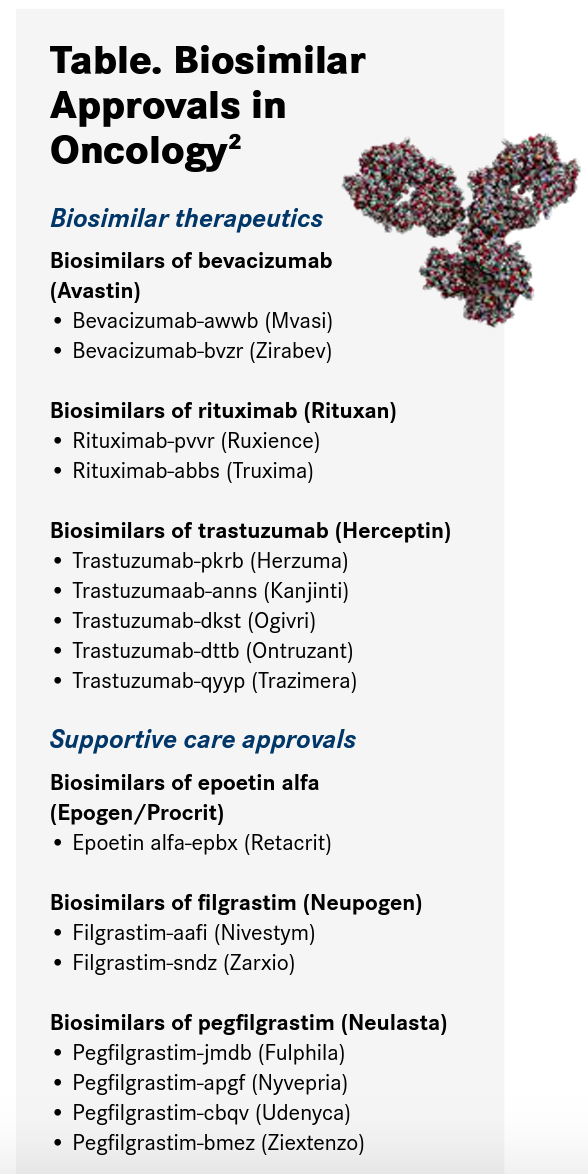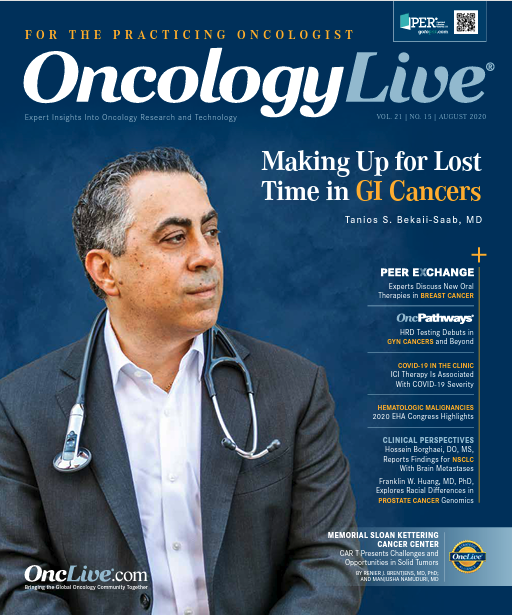US Biosimilar Portfolio Hits 10-Year Mark in Growth Mode
Since the US regulatory and litigation pathway for biosimilars was signed into law in March 2010, the FDA has approved 28 biosimilar products, including 16 drugs with indications for patients with cancer.
Ali McBride, PharmD, MS

Since the US regulatory and litigation pathway for biosimilars was signed into law in March 2010, the FDA has approved 28 biosimilar products, including 16 drugs with indications for patients with cancer.1,2 In oncology, the agency has authorized biosimilar versions of the therapeutic monoclonal antibodies trastuzumab (Herceptin), bevacizumab (Avastin), and rituximab (Rituxan), as well as biosimilars for the supportive care agents pegfilgrastim (Neulasta), f ilgrastim (Neupogen), and epoetin-alfa (Epogen) (Table).2

These new agents are part of the large and rapidly growing market for biologics. In 2005, biological products accounted for more than 39% of the $9.5 billion Medicare spent on prescription drugs. By 2014, Medicare’s drug spending had risen to $18.5 billion, with 62% of that spent on biologics and 42% was spent on cancer therapies.3
The introduction of biosimilars into the market is expected to decrease drug spending. In a 2017 RAND Corporation study, researchers estimated that the use of biosimilars would lead to a $54 billion reduction in direct spending on biologic drugs from 2017 to 2026—or about 3% of the total estimated spending on biologics during the same period.4
Ali McBride, PharmD, MS, clinical coordinator of hematology and oncology in the Department of Pharmacy at the University of Arizona Cancer Center and president of the Association of Community Cancer Centers (ACCC) for the 2019-2020 term, discusses integrating biosimilars into care models and the ACCC’s efforts to foster education about the drugs.
OncologyLive: We’re moving into the age of biosimilars. What does that mean for oncology practices and providers?
McBride: It’s a multifaceted approach. Right now, with the advent of the number of biosimilars coming into the market, it provides open access to patients, which means we’re going to be driving down health care costs. In an age where we’re looking at alternative payment models, we’re looking at reducing overall total health care costs. The introduction of biosimilars provides probably the best option for that decrease. As we look through and actually see the evolution of biosimilars in the United States versus the European Union and also other European countries, we have other issues to address.
Some of the things that we have faced [in] the United States versus the European Union are very different. We have a lot of different payers involved, [whereas] they have a socialized medicine system in some of those areas. But looking through this and kind of gleaning through in a very short and succinct answer, the biggest piece will be increasing access to the lower costs for our health care system— decreasing the national health care costs with biosimilars in oncology, supportive care, and even, for example, in rheumatology and for patients who need insulin. [That is] another area where biosimilars are coming into play, as they’ve reclassified biologics as well, which happened in 2020.
The other piece, which is going to be the implementation of this process, is of course the focus on how we integrate, which is one of the things ACCC [can do well]. And that will mean looking at monographs, addressing formulary, looking at reimbursement, and also understanding how it actually integrates into your IT [information technology] system, especially for oncology drugs, a very large part of our workflow.
Can you expand on the ACCC initiative to help with biosimilar integration into daily practice?
We’re starting on several initiatives [that] we’ll be addressing—the how to’s. But one of the things that we have to address is what reimbursement looks like with a biosimilar. Are you doing that correctly? What does patient assistance look like? Patient assistance is a key piece of the puzzle nowadays with oncology therapies. Other areas that we have to address are IT, EMR [electronic medical record] systems, and pharmacovigilance, which is a key issue across the board and is looking at the outcomes.
One of the things with biosimilars is that a key initiative by the FDA was to make sure that we address pharmacovigilance, which, for many of us, we’ve been doing in the pharmacy world for many years. [It is] often called [a] retrospective study. So, rather simply put, we have the ability here to address pharmacovigilance and address the outcomes as well.
But the education piece is one of the biggest areas we need to delve into. ACCC [is focused on educating] all members, as well as the patients who may receive these therapies, to ensure that we all are on the same foundation or level for integrating biosimilars into practice. Right now, we are looking at 4 to 5 to maybe 6 trastuzumab therapies [and] bevacizumab therapies; we just had 2 rituximab-based therapies approved with more coming online shortly. So you can imagine some of the repetition that may occur and also some of the issues that may occur with payers, as they may prefer one therapy over another.
For my presidency [of ACCC], I actually wrote a column called, “The Year of the Biosimilar,” which is 2020. And this is 2020, and we’re already seeing the onset. The amount of work being done by our health care teams, regardless of who you are, where you are in that structure, takes a lot of time to integrate these biosimilars into practice because we have to address getting the orders in correctly. We do that, we have our own formulary, but then the payer may have their own form line. That’s going to [create some] havoc. So then we have to change orders. We have to make sure that we can put those biosimilars into the stock and [that] we have them available to the patients so we can bill appropriately based on that payer.
You may also have issues with transition of care. We know that in some cases, for example, you may be using a short-acting growth factor in patients, and they may be discharged. You may get a short-acting growth factor outpatient. You may get a different drug because you’re working with an inpatient formulary versus potentially a specialty pharmacy formulary. So how do you work to really reduce any type of time associated [with delays in receipt of the drug]?
What are the biosimilar knowledge gaps in the oncology community?
I think it’s not just oncology. We’re talking about oncology right now, but it’s actually oncology and nononcology—rheumatology is a big one. I think also [there is a gap] with diabetes. We have insulin coming down the pipeline, too. We have a follow-on biologic, which did not go through the biosimilar pathway for long-acting insulin. We’ll probably see more of those shortly.
Let me just say that very [simply, there] is an across-the-board lack of education. So we have about, as I said, 3 to 5 years of education to really pin down these issues. We’re looking at oncology, where the biggest issue coming up is education on these therapeutic areas. We often are not really educating the members, [which] can be the health care teams, the physicians, nurses, pharmacy team members, and pharmacy technicians. We have live education on what a biosimilar is.
So going back to Biosimilars 101, we’re almost there but not there yet. We also need to address the therapeutic outcome of using a biosimilar. ASCO [American Society of Clinical Oncology] in 2018 had a survey that showed that a lot of physicians did not want to use biosimilars in oncology for first-line therapeutic curative therapies.5 A recent survey found oncologists are less likely to prescribe these drugs when there is a potential the practice could lose money. 6 There’s a feeling of uneasiness when using biosimilars in this area, especially for therapeutic outcomes that can be curative. Rituximab, trastuzumab for lymphoma and breast cancer, respectively.
But [the] other area [that] I think [impacts] the practices across the country is the pure lack of knowledge for reimbursement. And to me, I think that is across the board, the biggest area that we can address. We see people who are experienced with reimbursements [but] not aware of pass-through status for biosimilars, not aware of the potentials for these therapies in these areas and also the reimbursement coming up front.
And if you’re in an alternative payment model—again with ACCC’s experience in this area, this is an easy way to invest in the education area—it is to really look at how [advanced payment models] will actually benef it with the introduction of biosimilars and utilization for patients. And that will probably continue until the next iteration of OCM [Oncology Care Model] or OCF [Oncology Care First], or it may actually change thereafter. We’ll see what happens there. But with that, we now have the means to reduce some of those costs of care, especially as biologic therapies continue to rise in price.
References
- Royzman I, Shah K. 10 years of biosimilars: lessons and trends. Nat Rev Drug Discov. 2020;19(6):375. doi:10.1038/d41573-020-00081-5
- 2. Biosimilar product information. FDA. Updated May 13, 2020. Accessed June 1, 2020. https://www.fda.gov/drugs/biosimilars/biosimilar-product-information




